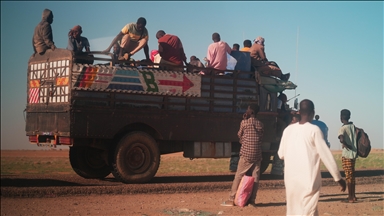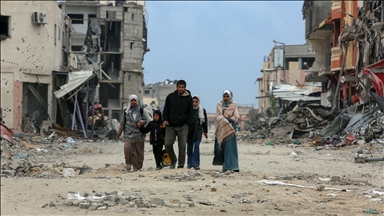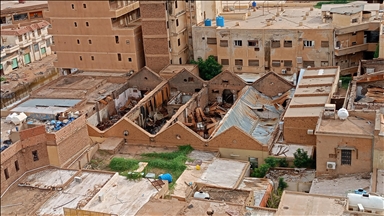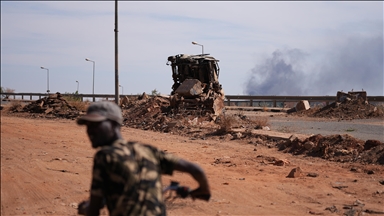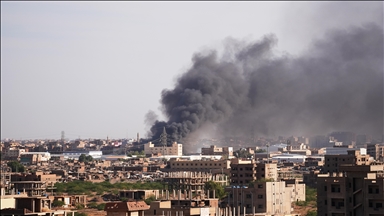FACTBOX - 2 years of war: Tens of millions at risk as deadly conflict shatters Sudan
Sudan’s civil war has uprooted nearly 15M people and killed an estimated 150,000 as the conflict enters its 3rd year with over 30M in need of humanitarian aid and 24.6M facing a deepening food crisis
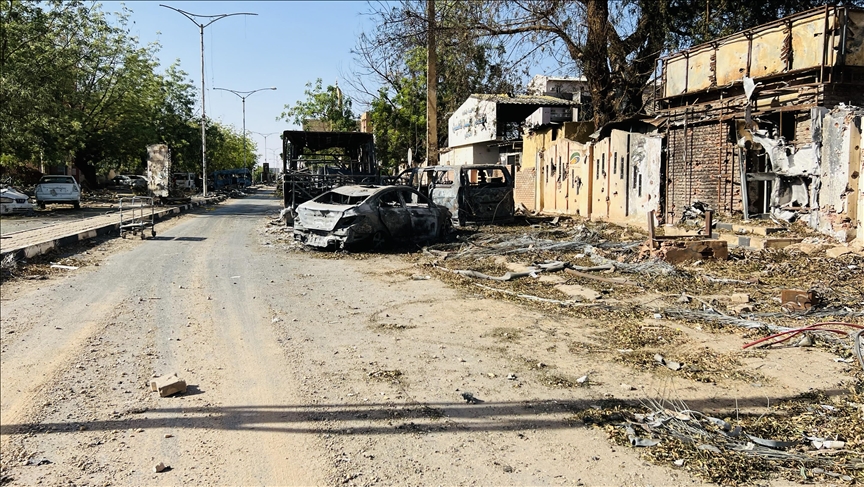 Traces of conflict in Sudan's Capital, Khartoum
Traces of conflict in Sudan's Capital, Khartoum
- The army has won a significant victory as it brought the capital Khartoum under its control in recent weeks, while the focus has now shifted to North Darfur, where dozens have been killed in the paramilitary RSF group's siege on regional hub el-Fasher
- Gender-based violence has surged across Sudan, with 12.1M at risk and children as young as 1 year targeted in sexual assaults amid widespread displacement and lawlessness
ISTANBUL
Sudan’s civil war, now entering its third year, has spiraled into one of the world’s worst humanitarian crises, with tens of thousands killed and millions forced from their homes.
The conflict, which erupted on April 15, 2023, pits the Sudanese Armed Forces (SAF) led by Gen. Abdel Fattah al-Burhan against the paramilitary Rapid Support Forces (RSF), commanded by his former deputy Mohamed Hamdan Dagalo, known as Hemedti. As the fighting rages on, civilians continue to bear the brunt — trapped between airstrikes, ground attacks, famine, and disease.
Despite repeated international efforts to broker peace, including failed ceasefires and faltering negotiations, little progress has been made toward ending the violence.
Recent weeks have seen major gains by the military, recapturing the capital Khartoum and forcing the RSF to withdraw from key sites including the presidential palace and airport.
The SAF maintains its hold over eastern Sudan and parts of the north, but the most intense fighting has since shifted west, particularly around el-Fasher — the last major city in Darfur under army control.
The city, located in North Darfur state, is now under siege by RSF forces. With shelling continuing for days, humanitarian access has become increasingly restricted and aid agencies warn that the situation could deteriorate even further in coming months.
Death, displacement, and escalating violence
The scale of the crisis is staggering. More than 30 million people — over half the country’s population — now require humanitarian assistance, according to the UN. Recent estimates place the death toll at around 150,000.
Nearly 15 million people, or one in three Sudanese, have been uprooted. The UN’s International Organization for Migration (IOM) reports that 11.3 million are displaced within Sudan, including 8.59 million since the war began. An additional 3.9 million have fled to neighboring countries.
Egypt, Chad, South Sudan, the Central African Republic, Ethiopia, Libya, and Uganda have become the main destinations for refugees seeking safety from the relentless conflict.
Gender-based violence has surged in tandem with displacement. In under two years, the number of people at risk has tripled to 12.1 million — roughly a quarter of the population — while the number of survivors seeking support more than quadrupled between December 2023 and December 2024, according to UN agencies.
“Perpetrators have primarily targeted women and girls but men and boys are not spared,” UNICEF has said.
Children in the crossfire
Children are among the hardest hit. With 41% of Sudan’s population under the age of 15, they face extreme risks — including sexual violence, forced recruitment by armed groups, and loss of education.
Since the beginning of 2024, at least 221 cases of child rape have been recorded, according to UNICEF, which has warned that “children as young as one” have been targeted.
Grave violations against children rose 16% in 2024 compared to the previous year — which had already seen a staggering 473% spike from 2022.
The education system has all but collapsed. Some 90% of Sudan’s 23,000 schools remain closed, leaving 19 million children out of school — one of the world’s largest education crises. In many conflict zones, school buildings now serve as shelters for displaced families, even as they remain vulnerable to attacks.
Hunger spreads fast
Sudan’s food crisis is deepening rapidly. According to the Integrated Food Security Phase Classification (IPC), 24.6 million people now urgently need food assistance — including at least 638,000 on the brink of starvation.
That’s 3.5 million more than previously estimated.
Farming has ground to a halt in many conflict zones. Fields lie abandoned, livestock has been looted, and displaced families often lack access to harvests or markets. In displacement camps and besieged areas, hunger is acute.
Famine has already taken hold in more than 10 areas, including the Zamzam, Abu Shouk, and Al Salam camps in North Darfur, as well as parts of the Western Nuba Mountains. Another 17 localities are on the verge of famine, humanitarian organizations warn.
The toll is particularly severe on young children and mothers. In 2024, acute malnutrition affected 4.9 million children under five and pregnant or nursing women — a 22% spike from the previous year, according to the World Health Organization (WHO).
Health system in collapse
Sudan’s fragile health system is also crumbling under the weight of war.
More than 542 attacks on healthcare facilities have been documented since April 2023, the WHO says. At least 122 health workers have been killed and 90 detained. With many clinics destroyed or abandoned, access to even basic care is vanishing.
Maternal health is at risk. More than a million pregnant women urgently need reproductive care, with up to 130,000 newborns and 95,000 mothers expected to face life-threatening complications during childbirth this year alone.
Two-thirds of Sudan’s 18 states are battling simultaneous outbreaks of malaria, dengue, measles, and cholera. The cholera outbreak alone has claimed 1,567 lives.
“Given the high rates of malnutrition, a debilitated health system and low immunization coverage, disease outbreaks will continue to have catastrophic impacts, particularly for children,” the WHO warned.
Anadolu Agency website contains only a portion of the news stories offered to subscribers in the AA News Broadcasting System (HAS), and in summarized form. Please contact us for subscription options.


